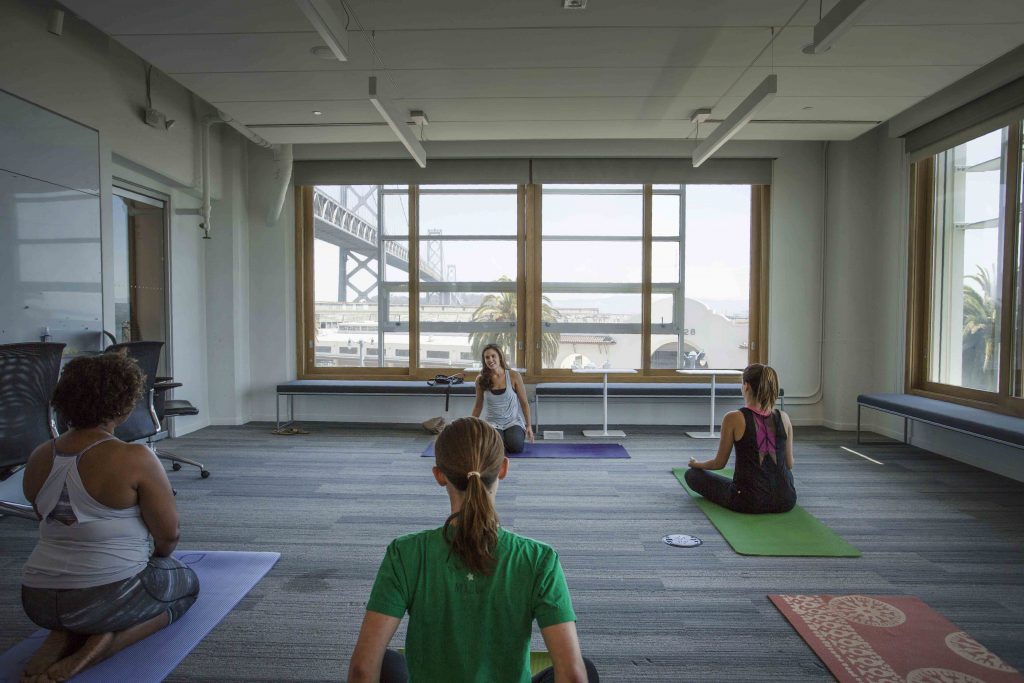Health and wellness can be many things to many people, and individuals will always have a preference over what works for them.
But for an employer, ensuring staff have the mental and physical capacity to perform to the best of their abilities with a smile on their faces can reap rewards far beyond the bottom line.
There are many things that make up an ideal workplace, though. The nine winners of the inaugural Employee Recommended Workplace Award, which recognises companies that prioritise the health and wellness of their staff, describe the one thing that helps their company stand out from the rest.
Family first
“As a theoretical physics institute, we’re trying to create a fantastic environment for the world’s top scientists and their families.
“So we’ve got a room for kids to hang out. We have an extremely family-friendly facility here. This building is full of blackboards, because everybody writes on blackboards. It’s not uncommon to see blackboards full of math on the top section and down at the bottom doodles of cats or fish because we have a lot of events where we have families come into the building. For example, every week there’s something called family night in our restaurant.”
Michael Duschenes, managing director and chief operating officer, Perimeter Institute for Theoretical Physics, Waterloo, Ont.
Full engagement
“The most important thing for us is that the health and wellness program has an important impact in our community because we work on the program with the staff but also with students.
“Students don’t make one action and personnel the other action. They all make moves together on the same things. That’s very original.
“And it’s received well because the program came from them, not from me or the direction team, so it’s implanted within the mentality of our culture within Cégep Garneau.”
Denise Trudeau, executive director, Cégep Garneau, Quebec City
Importance of communication
“The No. 1 thing is communication with the people. When I was at a conference this weekend there was a sign up that said whenever information is missing, people fill in the blanks. So when they don’t know what’s going on, most people fear the worst.
“It can be something as simple as when there are visitors to the office, we send out an e-mail to let everybody know who it is because in today’s culture, you see someone new walk through the building, you think: Is the company being sold, are we going to be out of a job? People never know.
“So then when we have visitors they see everybody smiling and most people will say hi to them because they know who they are.”
Scott Foster, director of sales and marketing, NEBS PAYweb and Payce payroll companies, Cambridge, Ont.
Whole-person development
“People are leading busy lives. We’re in the client service business, so we’re basically on 24/7.
“Our whole-person development program was designed to equip staff with a toolkit that they could draw from for sources of energy when things get stressful.
“We’ve done an eight-week course in mindfulness, we’ve done work around energy management, which incorporates nutrition, healthy snacking, water consumption, getting good sleep.
“It’s a whole person development program built around mind, body and spirit content.”
Sarah Liverance, partner, Sklar Wilton & Associates Ltd., Toronto
Empathise
“It’s our employee-centric culture and how we’ve embodied our core value of empathy in how we think about and treat our people.
“For example, we had an employee that had been going through some serious health issues and was also moving house. We took that as an opportunity to show our empathy and caring for their health and wellness by organizing a moving company to help them through that life experience.
“We have a Klick Experience Team whose job it is to proactively help nurture and grow culture and engagement at Klick through events and celebrations, and their job is to try and find those surprise and delight moments wherever they may exist.”
Glen Webster, senior vice-president of finance, Klick Inc., Toronto
Promote physical wellness
“For us wellness is everyday, it’s part of what we do here at our offices and we don’t think of it as wellness programming, it really is how we do our work.
“We have informal meetings on the treadmill. We put gyms in our corporate office, and because it’s such a normal thing to pop upstairs and go for a walk or a run or participate in a class, it just sort of becomes a place where we do business. You talk about work while you’re there, you talk about other things, too, but for us the lines are blurred a little bit and it really is part of the culture.”
Colleen McCarville, vice-president, human resources, Killam Apartment Real Estate Investment Trust, Halifax
Celebrate people
“We celebrate people’s milestones, if it’s a birthday, et cetera. So people will e-mail them, or if they’re in the same office, will stop by and say happy birthday or happy anniversary or good luck with this event that’s happening, that type of thing.
“We make sure we have pot lucks or socials that are happening here and there throughout the year. Everybody can come and share life, that type of thing. That culture is nourished here at the office or throughout our offices and it keeps growing.”
Danny Soucy, executive director, New Brunswick Association for Community Living, Fredericton
Be open to new ideas
“Don’t assume that you know what’s best. Not too long ago an employee introduced a meditation program that is now run on Skype for employees working offsite to join – this idea did not come from the management team but was a creative solution identified and launched by an individual employee.”
Alastair Macdonald, senior vice-president, human resources, Nestlé Canada Inc., Toronto
Be wide-ranging
“Our wellness education sessions, wellness fairs, annual health checks, healthy catered food, employee benefit programs that support active living and weight management, benefits that focus on preventative health care programs, an active health and safety committee, all contribute to employee health and wellness. Not all employees participate in every aspect of our health and wellness program but we believe there is something that everyone can benefit from.”
Sheila Kendall, vice-president, human resources, L.V. Lomas, Brampton, Ont.
How we chose the winners
Companies are discovering that paying attention to the wellness of their workforce can help their bottom line. Executives are learning that their employees’ personal lives don’t get left at the door to the office, and those issues can have an impact on an employee’s productivity levels and overall focus at work.
The Employee Recommended Workplace Award, jointly created by The Globe and Mail and Morneau Shepell, recognizes companies for excellence in achieving a healthy, engaged and productive workforce. And it’s an award based entirely on feedback from employees.
Here’s how the award works.
A company’s employees take a survey based on four pillars: work, life, mental health and physical health. Each employee gets a score based on their responses, and the aggregate of a company’s employee responses determine that organization’s score. The company with the top score is the Grand Prize winner in their category. It’s a very unique award that’s purely statistically based and in which employees determine if their company wins.
Those companies that meet a minimum statistical threshold earn the distinction of being awarded the Employee Recommended Workplace Award Badge and are considered finalists.
This is no small feat. It means those companies were in the top percentile of our participants and have a workplace that prioritizes the health and wellness of their staff.
Of our 32 finalists, there are nine Grand Prize winners. These are companies that had the top scores based on their company size and in their category of business.
In addition to the employee surveys, each organization completed an employer questionnaire in which companies outlined some of their key operating principles and the wellness programs they offered.
Several themes came to the fore in the questionnaires from our winners.
Most winners have a focus on mental health with training programs for their managers and a strategy to implement a mental health strategy.
They place importance on one-on-one manager and employee chats; they have regular employee engagement surveys and staff turnover is low.
These companies have zero tolerance policies regarding harassment and bullying and ensure their culture makes employees comfortable with reporting any negative incidents.
They are companies with flexible work options for their staff, such as flexible hours, job sharing and telecommuting.
These companies also offer an array of health and wellness programs that focus on areas such as healthy eating and physical activity.
From: The Globe and Mail



